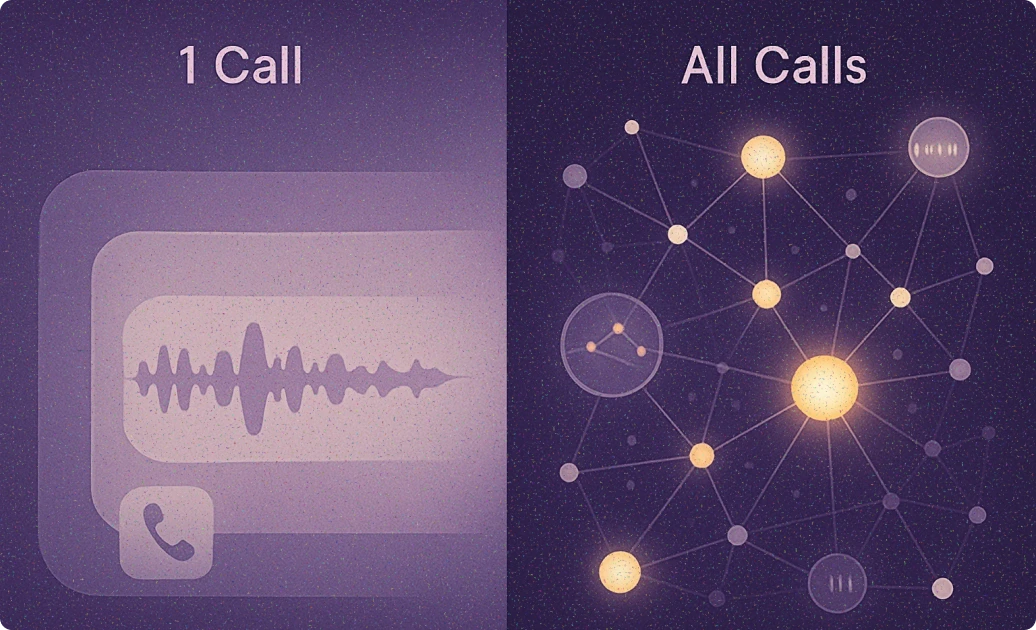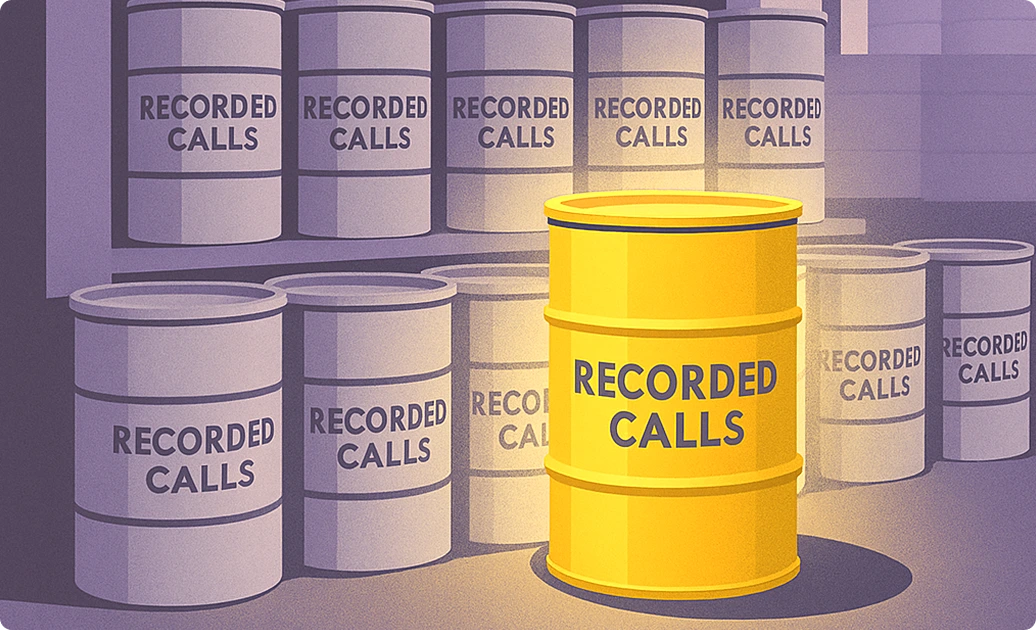Tracking Conversion Drop-Offs with AI Call Analytics
-
Bella Williams
- 10 min read
Tracking Conversion Drop-Offs with AI Call Analytics
Understanding customer interactions is vital for B2B companies striving to enhance their product offerings and market strategies. With AI call analytics, businesses can now track conversion drop-offs more effectively, turning insights from customer conversations into actionable strategies. This guide explores the benefits of using AI-driven analytics to optimize customer success efforts and improve overall conversion rates.
The Role of Tracking Conversion Drop-Offs with AI Call Analytics in Modern Business
As businesses navigate a competitive landscape, efficiently tracking customer feedback has become essential. Traditional methods of gathering insights from customer interactions often fall short, leading to missed opportunities and unresolved issues. AI call analytics addresses these challenges by automating the review process, allowing teams to focus on what’s most important—enhancing customer experience and driving conversions.
This approach shifts organizations from reactive strategies reliant on manual analysis to proactive, data-driven decision-making. By harnessing AI, businesses can identify patterns and insights that inform product development and go-to-market (GTM) strategies while fostering alignment across various teams, including customer success, sales, and product development.
To implement AI call analytics effectively, organizations must invest in technology that integrates seamlessly with existing communication tools and platforms.
What is Tracking Conversion Drop-Offs with AI Call Analytics?
AI call analytics refers to the process of utilizing artificial intelligence to analyze recorded customer interactions, extracting valuable insights that can help businesses understand where and why conversion drop-offs occur. Unlike traditional methods, which often involve manual review and subjective interpretation, AI analytics provides real-time data and sentiment analysis, giving organizations a clear view of customer behavior and pain points.
Core Capabilities:
- Automated Insights: Quickly analyze large volumes of call data to identify trends and anomalies in customer interactions.
- Sentiment Analysis: Gauge customer satisfaction and sentiment through voice tone and language used during calls.
- Actionable Recommendations: Generate specific, data-driven suggestions for improving customer engagement and addressing common issues.
- Performance Metrics: Provide insights into agent performance and customer success metrics, allowing for targeted coaching and training.
- Integration with CRM: Seamlessly connect with platforms like Salesforce, Gong, and HubSpot to enrich customer profiles and interactions.
Strategic Value: By utilizing AI call analytics, organizations can make proactive decisions based on comprehensive data, enhancing alignment between product development and customer needs.
Why Are Consultants and Insight-Seeking Personnel Investing in Tracking Conversion Drop-Offs with AI Call Analytics?
Context Setting: The shift from traditional methods to AI-driven analytics is driven by the need for businesses to extract actionable insights from vast amounts of customer interaction data. Companies are recognizing that to remain competitive, they must leverage technology that enables quick adaptation to customer feedback and market demands.
Key Drivers:
- Increased Complexity: As customer interactions diversify across channels, traditional approaches become inadequate, leading to siloed data.
- Speed of Insights: AI provides the ability to analyze interactions in real-time, allowing for swift adjustments in strategy.
- Customization: Personalizing customer interactions based on insights leads to higher conversion rates and customer satisfaction.
- Resource Optimization: AI analytics frees up customer success teams from manual analysis, allowing them to focus on higher-value activities.
What Data Powers Tracking Conversion Drop-Offs with AI Call Analytics?
Foundation Statement: To effectively track conversion drop-offs, organizations must collect and analyze data from multiple sources, ensuring a holistic view of customer interactions.
Data Sources:
- Call Recordings: Capture customer interactions for analysis.
- CRM Systems: Integrate data from Salesforce, HubSpot, and others to provide context.
- Feedback Channels: Analyze customer feedback from surveys and social media.
- Support Interactions: Include data from support tickets and chat logs to identify common issues.
- Market Trends: Leverage external market data to understand broader trends affecting customer behavior.
Accuracy Benefit: A comprehensive approach ensures better insights, enabling organizations to identify root causes of conversion drop-offs and implement targeted strategies.
Key Components of a Tracking Conversion Drop-Offs with AI Call Analytics Stack
Stack Overview: The AI call analytics stack consists of several critical components that work together to provide organizations with robust insights.
Component Descriptions:
- Data Collection Module: Gathers recordings from various communication channels.
- AI Processing Engine: Analyzes speech and text data to identify patterns and sentiments.
- Analytics Dashboard: Visualizes key metrics and insights for user-friendly interpretation.
- Feedback Loop System: Generates recommendations and alerts for continuous improvement.
- Integration Layer: Ensures compatibility with existing CRM and communication tools.
Quality Emphasis: Ensuring the data collected is high-quality and relevant is crucial for the effectiveness of AI call analytics.
How Does Tracking Conversion Drop-Offs with AI Call Analytics Work Step by Step?
Step 1: Data Collection
Gather call recordings from platforms like Zoom and integrate with CRM systems to enrich data context.
Step 2: AI Processing
Utilize AI algorithms to transcribe and analyze calls, identifying keywords, sentiments, and patterns.
Step 3: Pattern Identification
Recognize trends in customer interactions, such as common complaints or reasons for disengagement.
- Complaint Trends: Identifies recurring issues impacting customer satisfaction.
- Engagement Patterns: Tracks how different customer segments interact with teams.
- Conversion Signals: Flags conversations that indicate a likelihood of conversion or drop-off.
Step 4: Feedback Loop
Develop actionable insights and recommendations based on the identified patterns, ensuring continuous improvement.
Step 5: Real-Time Processing
Enable real-time analytics during busy periods, allowing teams to intervene proactively when drop-offs are detected.
Step 6: Insight Delivery
Provide teams with specific recommendations and insights, such as:
- Improvement Suggestions: Tailored feedback for individual agents.
- Customer Engagement Strategies: Recommended approaches for re-engaging dropped leads.
- Training Opportunities: Identify areas for team development based on performance metrics.
Where Can Teams Apply Tracking Conversion Drop-Offs with AI Call Analytics?
Performance Optimization
- Prediction Method: Identify which agents have higher drop-off rates.
- Recommended Action: Provide targeted coaching to improve performance.
Customer Engagement
- Analysis Approach: Use sentiment analysis to score customer interactions.
- Follow-Up Action: Implement personalized outreach for customers showing dissatisfaction.
Training Development
- Identification Method: Analyze call data to identify common challenges faced by agents.
- Proactive Scheduling: Schedule tailored training sessions based on identified needs.
Forecasting Trends
- Forecasting Approach: Analyze historical call data to predict future customer behavior.
- Optimization Action: Adjust marketing strategies based on predicted trends.
What Tools Can You Use for Tracking Conversion Drop-Offs with AI Call Analytics?
When selecting a tool for AI call analytics, look for platforms that offer robust data integration capabilities and user-friendly interfaces. Tools like Insight7 can provide comprehensive analytics that integrates seamlessly with existing customer success processes.
Comparison Table:
| Feature | Insight7 | Traditional Call Analysis Tools |
|---|---|---|
| Automated Insights | High | Medium |
| Sentiment Analysis | Advanced | Basic |
| Real-Time Reporting | Yes | No |
| Integration Capability | Extensive | Limited |
| User Interface | Intuitive | Complex |
Common Pitfalls in Tracking Conversion Drop-Offs with AI Call Analytics Implementation
Context Warning: Many organizations make mistakes when implementing AI call analytics, leading to suboptimal outcomes.
Major Pitfalls:
- Lack of Alignment: Failing to align teams on goals can lead to fragmented efforts.
- Inadequate Data Quality: Poor data can result in misleading insights.
- Ignoring Human Element: Relying solely on AI without human oversight can overlook critical nuances.
- Integration Challenges: Difficulty in integrating with existing systems can limit effectiveness.
Success Foundation: Establishing a clear strategy and ensuring stakeholder alignment is crucial for successful implementation.
How Do You Get Started with Insight7?
Step 1: Integration
Connect Insight7 with existing communication and CRM platforms for seamless data flow.
Step 2: Data Synchronization
Ensure that all relevant data sources are integrated for comprehensive analysis.
Step 3: Configuration
Customize the platform settings to align with organizational goals and reporting preferences.
Step 4: Training
Utilize historical data to train the AI models for more accurate insights.
Step 5: Customization
Adapt the platform to meet the unique needs of different teams and stakeholders.
Step 6: Ongoing Optimization
Regularly review and optimize processes based on performance metrics and user feedback.
What Is The Best Tracking Conversion Drop-Offs with AI Call Analytics Setup?
ROI Optimization: To maximize return on investment, organizations should focus on best practices.
Best Practices:
- Diversity of Data: Integrate data from multiple sources for comprehensive insights.
- Stakeholder Involvement: Engage all relevant teams in the implementation process.
- Historical Data Timeframe: Utilize a range of historical data for better predictive accuracy.
- Review Cadence: Establish regular review intervals to assess performance and refine strategies.
- Automation Integration: Leverage automation to streamline processes and reduce manual workload.
Tracking Conversion Drop-Offs with AI Call Analytics Benchmarks and Success Metrics
Evaluation Framework: Clear benchmarks are essential for measuring the impact of AI call analytics.
Core Metrics:
- Conversion Rate: Measures the percentage of leads that convert into customers.
- Customer Satisfaction Score: Gauges overall customer satisfaction.
- Agent Performance Metrics: Evaluates individual agent effectiveness based on call outcomes.
- Engagement Rate: Measures the level of customer engagement during interactions.
- Feedback Loop Effectiveness: Assesses the impact of implemented recommendations on performance.
Universal Principle: The overarching rule is that value comes from making better decisions and taking informed actions based on data-driven insights.
Frequently Asked Questions
Q: What is AI call analytics?
A: AI call analytics involves using artificial intelligence to analyze customer interactions, providing insights that help businesses understand customer behavior and improve conversion rates.
Q: How does it differ from traditional call analysis?
A: Traditional methods often rely on manual review, while AI analytics automates the process and provides real-time insights.
Q: What platforms is Insight7 compatible with?
A: Insight7 integrates seamlessly with platforms like Salesforce, Gong, and HubSpot.
Q: What data is needed for effective AI call analytics?
A: Ideal data sources include call recordings, CRM data, and customer feedback from various channels.
Q: How long does implementation take?
A: Implementation speed can vary, but organizations typically see value within weeks of setup.
Q: How does Insight7 ensure compliance with data regulations?
A: Insight7 adheres to industry standards and regulations, ensuring data security and compliance.
Analyze & Evaluate Calls. At Scale.

Extract insights from interviews, calls, surveys and reviews for insights in minutes
Analyze & Evaluate Calls. At Scale.








